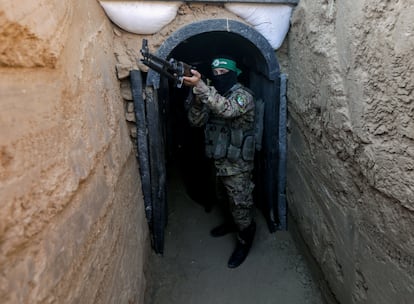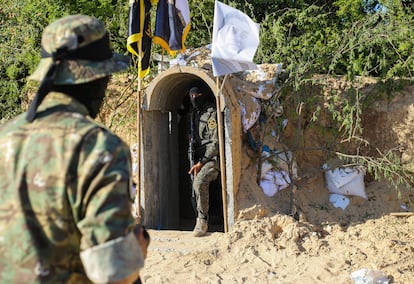The ‘Gaza metro,’ Hamas’ secret weapon against an Israeli invasion
The Israeli army has never succeeded in destroying the underground network of communications, shelters, command posts and hostage cells used by the Islamist militia within the Strip

The sandy soil of Gaza is Israel’s worst enemy. It has been dug almost by hand, away from prying eyes, for more than three decades, to carve one of the largest networks of tunnels and passageways on the planet in one of its tiniest territories. The General Staff of the Israel Defense Forces has dubbed it the “Gaza metro” — a strategic network of dozens of kilometers of subterranean galleries for military use, considered to be Hamas’ secret weapon in the face of an Israeli invasion. Unlike the smuggling tunnels on the border with Egypt, or the attack passages dug under the border with Israel, no one has lived to tell the tale of having seen Gaza’s so-called metro.
The primary target of Israel’s looming invasion is expected to be this network of subterranean shelters where Hamas’ political leaders and the commanders of its armed wing, the Izz ad-Din al-Qassam Brigades, are suspcted to be hiding. In 2014, Israel launched a full-scale war, which included an extensive ground operation, over two months, to destroy the subterranean network. In 2021, in the Israeli army’s last major incursion, it again proclaimed the destruction of the underground passages, while justifying the shelling of the residential neighborhood of Rimal, in Gaza City, where dozens of civilian casualties were reported. However, after 11 days of intense bombardment, in the craters and holes left by the bombs there was only sand. When the foreign press was able to visit the area, there was no trace of the tunnels.
“Hamas claims there are 500 kilometers (310 miles) of tunnels. But I think that figure is a way of discouraging Israel from invading Gaza,” explains Harel Chorev, a historian and researcher at the Dayan Center at Tel Aviv University. “What is certain is that there are dozens of kilometers constructed, from where rockets are launched and weaponry is stored. There are also supply rooms, water reserves, electronic devices and everything you might need in the event of an attack,” he said via a video call.
The labyrinth of tunnels, some of which run more than 30 meters deep, is one of the best-kept secrets of the Hamas militia command. Unlike Al-Qaeda’s spider webs of passageways at Tora Bora in mountainous eastern Afghanistan two decades ago, or the sophisticated complexes dug by the Vietcong on Vietnam’s jungle frontiers 50 years ago, Hamas’ tunnel network runs underneath densely populated urban areas. To destroy it, Israel would have to flood the tunnels — as Egypt did with the smuggling routes connecting Sinai and Gaza — or blow them up, as Israeli forces did with the galleries it found within its borders. Another option would be to use bomb disposal robots to defuse any booby traps before storming the tunnels with infantry.
The U.N., through its UNRWA agency for Palestinian refugees, has been the only source other than the warring sides to record the existence of the tunnel network. Last year, a “man-made cavity” was located under the grounds of one of the U.N. agency’s schools in Gaza. UNRWA denounced the discovery as a violation of its neutrality in the conflict and described it as a threat to the safety of students.

Israel has captured dozens of militiamen from the intelligence services of the Nujba, the elite unit of the Izz ad-Din al-Qassam Brigades, notes Professor Chorev. “They were trained in the tunnels and probably know the entrances and exits of the network precisely,” he says. “One of the biggest challenges for the [Israeli] armed forces is that it is not known what kind of weapons Hamas has in the tunnels, just as it did not know Hamas’ attacking capability before October 7,” he warns.
Before building a subterranean barrier around the Gaza Strip at a cost of over $1 billion, Israel systematically bombed tunnels leading into its territory between 2013 and 2014, burying dozens of Hamas and Islamic Jihad militants alive. In 2013, Egypt flooded the smuggling galleries used to circumvent the blockade imposed on Gaza with sewage. Hamas responded by firing rockets into Israel, many of which were intercepted and shot down by the Iron Dome defensive shield.
But when it comes to the tunnels inside Gaza, Israel lacks an alternative to massive bombardments — resulting in civilian casualties — or a ground operation against a guerrilla group specialized in urban combat.
“In 2014 we knew there were tunnels crossing into Israel, but now we know there are dozens of networks moving from inside the Strip itself,” acknowledges Raphael Cohen, a researcher specializing in the Middle East at the RAND Corporation, by telephone. “Israel prefers to fight from the air. Once the military comes in on the ground, a lot of the army’s intelligence is going to be obsolete. At the moment, they only have a rough idea of these networks and they have been training for an [underground] battle,” the expert adds.
“There is no clear way to operate militarily in Gaza. Period. With its population density (more than 2.2 million inhabitants in just 365 square kilometers), there are always going to be problems protecting civilians, whether in air strikes or a ground incursion, which is essential if hostages are to be rescued,” Cohen stresses, before concluding that “you can’t destroy an extensive network of tunnels by bombing alone, as has been attempted up to now.”
Hamas’ October 7 attack left more than 1,400 people dead in Israeli territory, mostly civilians. About 200 people were taken hostage and are now being held underground in the Palestinian coastal enclave. In response, Israeli military airstrikes have since killed at least 3,785 Palestinians, according to the latest updates from the Hamas-run Ministry of Health in Gaza.
Sign up for our weekly newsletter to get more English-language news coverage from EL PAÍS USA Edition
Tu suscripción se está usando en otro dispositivo
¿Quieres añadir otro usuario a tu suscripción?
Si continúas leyendo en este dispositivo, no se podrá leer en el otro.
FlechaTu suscripción se está usando en otro dispositivo y solo puedes acceder a EL PAÍS desde un dispositivo a la vez.
Si quieres compartir tu cuenta, cambia tu suscripción a la modalidad Premium, así podrás añadir otro usuario. Cada uno accederá con su propia cuenta de email, lo que os permitirá personalizar vuestra experiencia en EL PAÍS.
¿Tienes una suscripción de empresa? Accede aquí para contratar más cuentas.
En el caso de no saber quién está usando tu cuenta, te recomendamos cambiar tu contraseña aquí.
Si decides continuar compartiendo tu cuenta, este mensaje se mostrará en tu dispositivo y en el de la otra persona que está usando tu cuenta de forma indefinida, afectando a tu experiencia de lectura. Puedes consultar aquí los términos y condiciones de la suscripción digital.
More information
Archived In
Últimas noticias
Most viewed
- David King, chemist: ‘There are scientists studying how to cool the planet; nobody should stop these experiments from happening’
- Reinhard Genzel, Nobel laureate in physics: ‘One-minute videos will never give you the truth’
- Mexico completes its trade shift with the entry into force of tariffs on China and countries without trade agreements
- Oona Chaplin: ‘I told James Cameron that I was living in a treehouse and starting a permaculture project with a friend’
- Sinaloa Cartel war is taking its toll on Los Chapitos










































